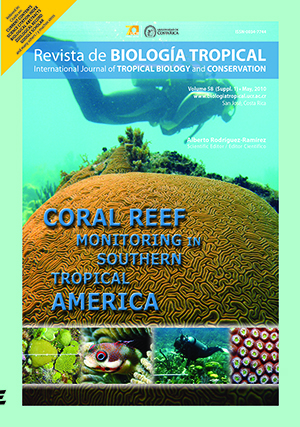Abstract
Colombian coral reefs, as other reefs worldwide, have deteriorated significantly during the last few decades due to both natural and anthropogenic disturbances. The National Monitoring System for Coral Reefs in Colombia (SIMAC) was established in 1998 to provide long-term data bases to assess the changes of Colombian coral reefs against perturbations and to identify the factors responsible for their decline or recovery. On the Pacific coast, data on coral and algal cover have been collected yearly during seven consecutive years (1998-2004) from 20 permanent transects in two sites at La Azufrada reef, Gorgona Island. Overall, coral cover was high (55.1%-65.7%) and algal cover low (28.8%-37.5%) and both exhibited significant changes among years, most notably on shallow areas. Differences between sites in both coral and algal cover were present since the study began and may be explained by differences in sedimentation stress derived from soil runoff. Differences between depths most likely stem from the effects of low tidal sub-aerial exposures. Particularly intense sub-aerial exposures occurred repeatedly during January-March, 2001 and accounted for a decrease in coral and an increase in algal cover on shallow depths observed later that year. Additionally, the shallow area on the Northern site seems to be negatively affected by the combined effect of sedimentation and low tidal exposure. However, a decrease in coral cover and an increase of algal cover since 2001 on deep areas at both sites remain unexplained. Comparisons with previous studies suggest that the reef at La Azufrada has been more resilient than other reefs in the Tropical Eastern Pacific (TEP), recovering pre-disturbance (1979) levels of coral cover within a 10 year period after the 1982-83 El Niño, which caused 85% mortality. Furthermore, the effects of the 1997-98 El Niño, indicated by the difference in overall live coral cover between 1998 and 1999, were minor (<6% reduction). Despite recurrent natural disturbances, live coral cover in 2004 was as high as that existing before 1982 at La Azufrada, and one of the highest observed on healthy coral reefs in the TEP region.Comments

This work is licensed under a Creative Commons Attribution 4.0 International License.
Copyright (c) 2010 Revista de Biología Tropical
Downloads
Download data is not yet available.






